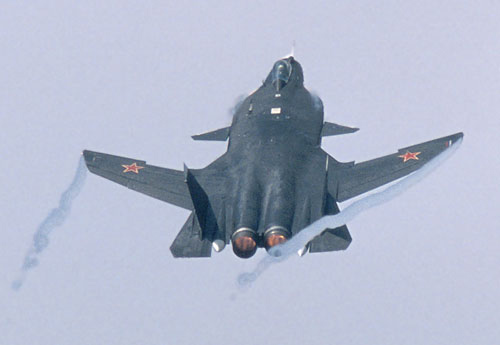Sukhoi Su-47 Berkut
Summary
| Category | Combat aircraft |
| Origin country | 🇷🇺 Russia |
| First flight | 25 September 1997 |
| Year of introduction | |
| Number produced | 1 units |
Description
The Su-47 Berkut, whose initial prototypes were designated S-32 and S-37 Golden Eagle, is an experimental aircraft derived from the Su-27 Flanker class. After a test campaign in 2001, Sukhoi was selected by the Russian government in May 2002 to be the manufacturer of the next-generation Russian fighter aircraft PAK FA, which will be a development of the Su-47.
The design of the Berkut is based on a reverse-swept wing (similar to that of the X-29) and the use of the natural instability of the airframe to increase its agility. It indeed has considerable maneuverability, even at supersonic speeds, thanks to the use of a reverse-swept wing that offers numerous advantages. The Su-47 is also equipped with small movable canard surfaces. The fuselage is composed of aluminum and titanium, as well as 13% of the weight in composite materials. The wings are made up of 90% composite materials. The Su-47 also appears to have fairly good stealth capabilities, although they are inferior to those of the F-22 Raptor. The cockpit has been designed to ensure maximum comfort for the pilot, even under high G-forces. It is equipped with a next-generation inclined ejection seat at 60°. The avionics and armament system of the Su-47 will be particularly advanced, notably the NIIP N011M radar.
Technical specifications
| Version: Su-47 Firkin | |
|---|---|
| Crew | 1 pilot |
| Maximum speed | 2500 km/h (1553 mph) |
| Wing area | 61.9 m² (666.0 sqft) |
| Wingspan | 15.2 m (49.7 ft) |
| Height | 6.3 m (20.7 ft) |
| Length | 22.6 m (74.1 ft) |
| Service ceiling | 18000 m (59055 ft) |
| Empty weight | 16375 kg (36101 lbs) |
| Max. takeoff weight | 35000 kg (77162 lbs) |
| Climb rate | 233.0 m/s (764.4 ft/s) |
| Powerplant | 2 × turbofans AL-37FU delivering 7598 kgp, up to 14515 kgp with afterburner |
Current operating countries
No country is operating the Su-47 Berkut in 2025.
All operators
Photo of Su-47 Berkut
